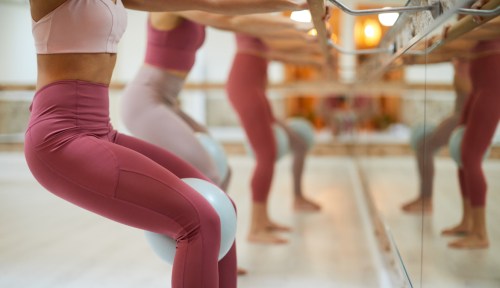When Your Muscles Start Shaking During a Workout, Should You Stop? Consider It a ‘Yellow Light,’ Say Experts
If you've experienced muscle shaking during a workout, it's a signal you shouldn't ignore. Learn why experts view this as a "yellow light."

Barre teachers often promise that muscle shaking is a good sign. They say shaking means that elevated plié or assisted chair pose is “working,” and that pushing through the shake will help build strength.
Experts in This Article
exercise physiologist at the Hospital for Special Surgery
pilates instructor and content creator
But recently, a stitched video went viral on TikTok that challenged this advice. In the clip, a user asks whether it’s normal for legs to shake during a Pilates class. Pilates instructor Norah Myers stitched the original video and advised, “If your muscles are shaking, stop, just full stop.” The stitched video has gotten 2.5 million views and nearly 1,000 comments.
Commenters described the advice as mind-blowing, and shared stories of how barre, Pilates, dance, sports, and even yoga instructors told them for years that shaking was a good thing, and to push through it. Some revealed that pushing through shaking left them with torn ligaments. Others were not so sure.
“The comments in that TikTok were so completely polarized,” Myers says. “So many people said, This makes so much sense, thank you so much for saying this. And then all the rest of the comments were like, You’re wrong. The shaking means it’s working, the pain means it’s working.”
So, to shake or not to shake?
Why your muscles shake during a workout
Muscle shaking during exercise can have two possible causes, according to Matthew Accetta, an exercise physiologist at the Hospital for Special Surgery. First, your muscles might be tired. Or they might be trying to do something they’re not used to, like a new movement or lifting a heavier weight. In both cases, shaking is a sign that your nervous system is trying to recruit more muscle fibers to get the job done.
“As muscle fibers become fatigued during exercise, your body needs to stimulate more muscle fibers, which require more motor neurons to fire,” Accetta says. “The impulses that travel through the nervous system and to the neuromuscular junctions to carry out activity are what cause the muscles to twitch and shake.”
If you’re trying out a new move, you might expect shaking. “When the body experiences a new stimulus, it might require new muscle fibers and neuromuscular junctions to activate,” Accetta says. “As those fibers and junctions activate for the first couple of times, they might twitch and shake until they become accustomed to the stimulus.”
This physiological explanation is what informed Myers’ TikTok advice.
“Your body’s sending you a signal that the muscle is fatiguing,” Myers says. She adds that you might start shaking if you’re not engaging the right muscles, so your body is trying to compensate by activating other muscles, which can cause the shaking and even possible cramping.
Should you stop doing an exercise if your muscles start shaking during a workout?
Shaking is not something that you should ignore, but it doesn’t necessarily mean you need to totally quit your workout, either. The best way to understand this signal is to think of shaking like a “yellow light,” according to Accetta.
“Muscle shaking during exercise should be viewed as a sign to slow down and be ready to take a break, kind of like a yellow traffic light,” Accetta says.
Myers agrees that the yellow light analogy is “the perfect way to put it.” She says, “It’s saying don’t go any further than where you are right now.”
The problems (and injuries) happen when people speed up and run the red light.
“If you push through the yellow light, you can ‘crash’ and hurt yourself,” Acetta says. “The red light is complete and total exhaustion and fatigue. We want to be able to catch ourselves and slow down before we blow through that red light. [Shaking] is not a sign to completely stop what we are doing, but should be viewed as a sign to prepare and get ready to stop.”
What happens if you keep going after your muscles start shaking during a workout?
The consequences of blowing through the yellow can be both mental and physical. “If we continue to exercise while we shake, we can cause excess strain and damage to our muscle fibers or prolonged soreness,” Accetta says. “The excess strain and muscle fiber damage can lead to joint sprains and muscle strains if there is no proper recovery time between exercises or reps.”
That prolonged soreness might turn you off from exercising more: If you’re giving it more than you should today, you might be hesitant to get back to the barre, gym, or reformer tomorrow.
What to do when your muscles start shaking
So how should we put that yellow light analogy into action? At the point when your muscles start shaking, you might want to switch up your form to something less taxing. For example, if you’re shaking in a plié with your heels lifted, consider dropping the heels, or rising up a bit higher so your knees aren’t bending quite as deep. Acknowledge that you probably only have a few more reps in you, and then give yourself a rest.
“There were so many comments [on TikTok] saying, I pushed through the shaking and then I couldn’t walk for two days, or my teacher encouraged me to push through the shaking and I eventually tore a muscle,” Myers says. “We think we have to just keep pushing through it because it means that it’s working. But that’s your body telling you that you need to pull it back.”
Sign Up for Our Daily Newsletter
Get all the latest in wellness, trends, food, fitness, beauty, and more delivered right to your inbox.
Got it, you've been added to our email list.










